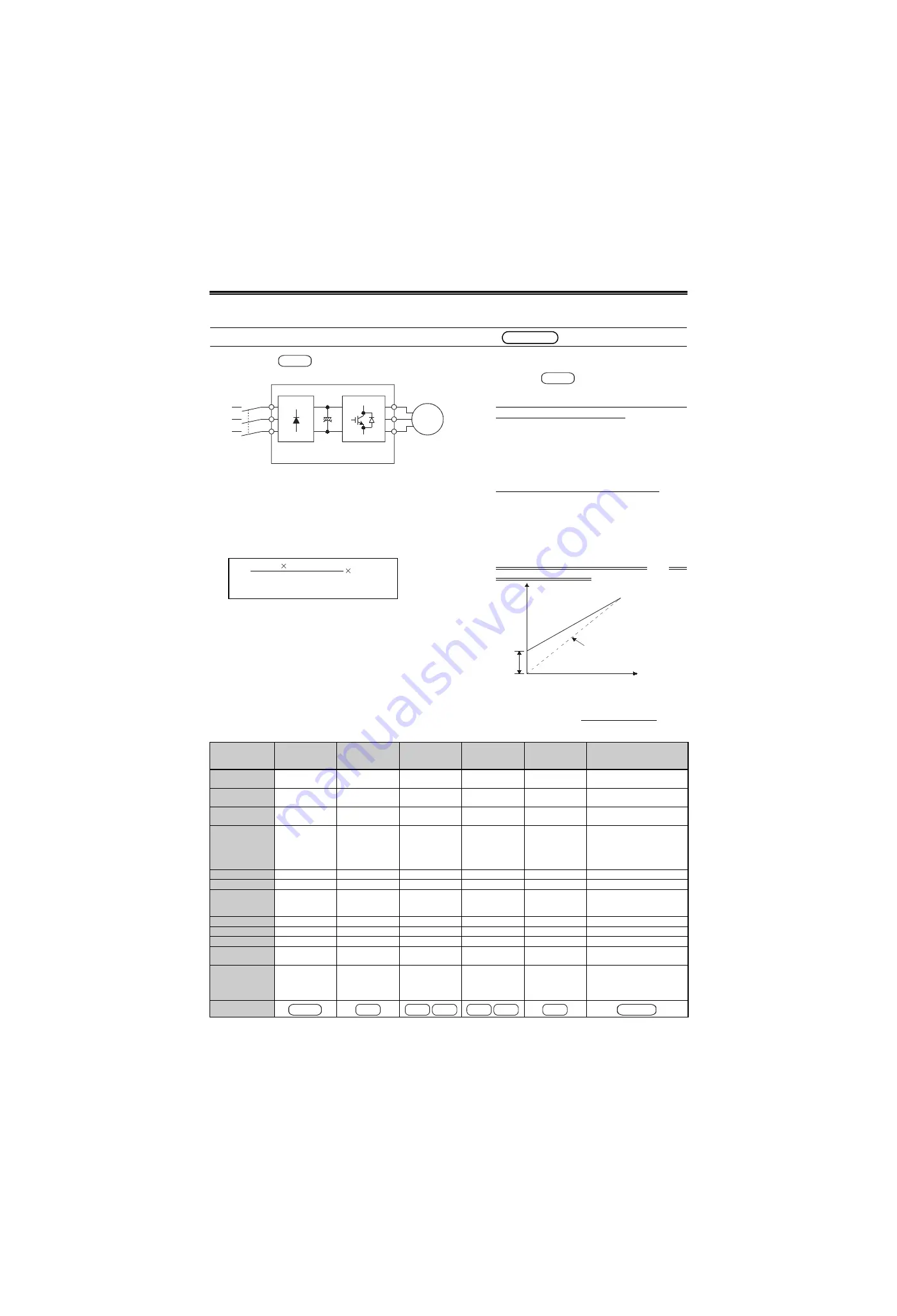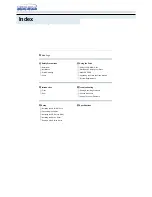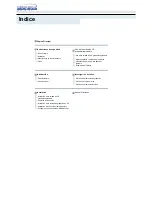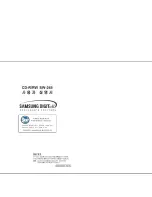
476
SELECTION
3.1 Inverter selection
3.1.1
Principle and control method of the inverter
(common)
(1) Principle
Inverter structure
The inverter rectifies commercial power into a DC
Voltage once in the converter circuit and converts it
into an AC Voltage of desired frequency in the
inverter circuit.
The speed N of the induction motor is expressed by
the following formula:
By changing the frequency (f) with the inverter, the
motor speed can be changed freely.
Actually, when the frequency (f) is changed, the
output voltage (V) is also changed to produce a
sufficient motor torque.
(2) Control Method
1) V/F control
When changing the frequency (f), the inverter
controls to make the ratio (V/f) of output frequency
(f) to output voltage (V) constant. This method is
the basic inverter control method and called V/F
control.
In this method, a sufficient torque will not be
developed since the actual effective voltage
decreases due to a voltage drop in the wiring and
motor's primary winding. This phenomenon has
greater influence as the speed gets lower. (Low-
speed torque will be short)
Hence, a voltage drop is pre-estimated to increase
the voltage (torque boost
*
) as indicated by the
continuous line in the figure below to compensate
for the torque shortage at low speed.
To make up for this disadvantage, we developed
Advanced magnetic flux vector control and Real
sensorless vector control.
* If the torque boost is too large, the torque is developed
sufficiently but an excessive current flows, causing the inverter
to be more easily resulting in an overcurrent (OCT) trip.
Comparison between Mitsubishi Inverter Control Method
common
common
Power
supply
MCCB
Converter circuit
Inverter circuit
Inverter
Motor
IM
AC Voltage
AC Voltage
DC
Voltage
120 f(frequency)
P(number of motor poles)
Where S is motor slip
N =
(1-S) [r/min]
common
Torque
boost
Voltage (V)
V/f = constant
Frequency (f)
0
Item
V/F Control
Simple Magnetic
Flux Vector
Control
General-Purpose
Magnetic Flux
Vector Control
Advanced
Magnetic Flux
Vector Control
Real Sensorless
Vector Control
Vector Control
Motor used with
inverter
Standard motor
(Mitsubishi, others)
Standard motor
(Mitsubishi, others)
Standard motor
(Mitsubishi, others)
Standard motor
(Mitsubishi, others)
Standard motor
(Mitsubishi, others)
Dedicated motor (Mitsubishi)
Standard motor (Mitsubishi, others)
Start several motors
at the same time
Enabled
Disabled
Disabled
Disabled
Disabled
Disabled
Auto tuning function
Not necessary
Not necessary
Equipped as
standard
Equipped as
standard
Equipped as
standard
Equipped as standard
Starting torque
low speed torque
1Hz: 30% or less
3Hz: 30%
6Hz: 80%
3Hz:120%
(when slip
compensation is set)
1Hz:150%
3Hz:200%
(3.7K or less)
(when slip
compensation is set)
0.5Hz: 150%
0.3Hz: 200/150%
(3.7K or less/5.5K or
more)
Dedicated motor
0Hz:150%
Standard motor
0Hz:200/150%
(3.7k or less/5.5k or more)
Speed detector
Not necessary
Not necessary
Not necessary
Not necessary
Not necessary
Necessary
Speed control range
1 : 10
1 : 15
1 : 60 (driving)
1 : 120 (driving)
1 : 200 (driving)
1 : 1500
Speed variation ratio
2 to 5%
Depends on load
magnitude
2 to 5%
Depends on load
magnitude
2 to 5%
Depends on load
magnitude
1%
Not influenced by
load
1%
Not influenced by
load
0.01%
Not influenced by load
Torque control
Disabled
Disabled
Disabled
Disabled
Enabled
Enabled
Speed control
Enabled
Enabled
Enabled
Enabled
Enabled
Enabled
Position control
Disabled
Disabled
Disabled
Disabled
Disabled
Enabled
Control response
level
10 to 20rad/s
20 to 30rad/s
20 to 30rad/s
20 to 30rad/s
120rad/s
300rad/s
(standard motor)
Applications
Fan, pump,
General industrial
machines, etc.
Fan, pump,
General industrial
machines, etc.
General industrial
machines, transfer
machines, lift
applications, etc.
General industrial
machines, transfer
machines, lift
applications, etc
General industrial
machines, transfer
machines, lift
applications, etc.
Transfer machines, lift application
line control, etc.
Applicable Inverters
common
F700
E700
D700
A700
E700
A700
A700+A7AP
Summary of Contents for FR-A700 Series
Page 245: ...279 2 PARAMETER PARAMETER MEMO ...
Page 440: ...474 PARAMETER MEMO ...
Page 522: ...556 SELECTION MEMO ...
















































